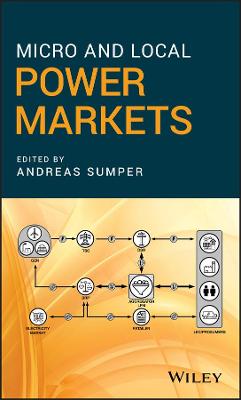Micro and Local Power Markets
 -15%
portes grátis
-15%
portes grátis
Micro and Local Power Markets
Sumper, Andreas
John Wiley & Sons Inc
07/2019
288
Dura
Inglês
9781119434504
15 a 20 dias
440
Descrição não disponível.
List of Contributors xi
Foreword xiii
Preface xv
1 Power Market Fundamentals 1
Ingrid Munne-Collado, Pol Olivella-Rosell and Andreas Sumper
1.1 Introduction 1
1.2 Basic Design of Power Markets 5
1.2.1 Organization 5
1.2.1.1 Monopoly 5
1.2.1.2 Purchasing Agency 5
1.2.1.3 Wholesale Market 5
1.2.1.4 Retail Competition 7
1.2.2 Bilateral Contracts and Auctions 7
1.2.3 Clearing 10
1.2.4 Settlement or Pricing 10
1.2.5 Example 11
1.3 Mechanism for Auctions 13
1.3.1 Why Auctions in Energy Markets? 13
1.3.2 Auction Basics 13
1.3.2.1 The Revenue Equivalence Theorem 14
1.3.3 Types of Auctions 15
1.3.3.1 The English or Ascending-Bid Auction 15
1.3.3.2 The Dutch or Descending-Bid Auction 15
1.3.3.3 The First-Price Sealed-Bid Auction 15
1.3.3.4 The Second-Price Sealed-Bid Auction 16
1.3.4 Auction Mechanisms Applied to Electricity Products 16
1.3.4.1 Sealed-Bid Auctions 16
1.3.4.2 Descending Clock Auction 17
1.3.4.3 Hybrid Auctions 18
1.3.4.4 Combinatorial Auctions 19
1.3.4.5 Two-Sided Auction Mechanisms 19
1.3.5 Auction Characteristics in Power Markets 19
1.3.6 Auction Design 20
1.3.6.1 Objectives Establishment 20
1.3.6.2 Object Identification 20
1.3.6.3 Participation Encouragement 21
1.3.6.4 Vulnerabilities in the Auction Mechanism 21
1.3.7 Example 23
1.4 Markets for Futures, Energy, and Balancing 27
1.4.1 Forward and Futures Markets 27
1.4.2 Spot Markets 28
1.4.3 Day-Ahead Markets 29
1.4.4 Intraday Markets 30
1.4.5 Balancing Markets 32
1.5 Conclusions and Further Reading 33
References 34
2 Local and Micro Power Markets 37
Ingrid Munne-Collado, Eduard Bullich-Massague, Monica Araguees-Penalba and Pol Olivella-Rosell
2.1 Introduction 37
2.2 Why Local and Micro? 38
2.3 The Evolution of Power Systems 40
2.4 Introduction to Microgrids 41
2.4.1 Microgrid Definition 41
2.4.2 Microgrid Components 43
2.4.3 Microgrid Operation Modes 45
2.4.3.1 Microgrid Connected to an External Distribution Grid 45
2.4.3.2 Microgrid Connected to Another Microgrid 46
2.4.3.3 Isolated Microgrid 48
2.5 Local and Micro Power Market Concepts 49
2.5.1 Local and Micro Power Market Definitions 49
2.5.2 Comparative Analysis 52
2.6 Local Market Design 59
2.6.1 Involved Agents and Stakeholders 60
2.6.2 Approach 63
2.6.2.1 Centralized (Pool-based) Approach 64
2.6.2.2 Peer-To-Peer 66
2.6.3 Services 68
2.6.3.1 Energy 68
2.6.3.2 Flexibility 70
2.6.4 Local Market Services and Approach Review 77
2.6.5 Local Market Interaction 81
2.7 Conclusions and Discussion 84
References 85
3 Micro Markets in Microgrids 97
Bernt Bremdal and Iliana Ilieva
3.1 Introduction 97
3.2 Basic Definitions of Micro Market Functions in Microgrids 99
3.2.1 Island Mode Versus Connected Mode 99
3.2.2 Market Approach for Resource Allocations 101
3.2.3 The Importance of Ownership, Business Focus, and Responsibilities 102
3.2.4 Capacity Design and Physical Laws 105
3.2.5 Resource Efficiency 105
3.2.6 Prerequisites for a Liberal Market 108
3.2.7 Basic Organizational Structures 109
3.2.8 Single Seller-Single Buyer 110
3.2.9 Multiple Sellers-Single Buyer 110
3.2.10 Single Seller-Multiple Buyers 112
3.2.11 Multiple Sellers-Multiple Buyers 112
3.3 Operational Characteristics of Microgrid-based Micro Markets 113
3.3.1 Types of Microgrid 114
3.3.2 Degree of Connectivity to Main Supply 114
3.3.3 Geography 119
3.3.4 Ownership 120
3.3.5 Business Models 120
3.3.6 Physical Control and Communication System 121
3.3.7 Management of the Microgrid 122
3.3.8 Number of Independent Buyers and Sellers 123
3.3.9 Type of Supply 123
3.3.10 Type of Loads 124
3.3.11 Storage Capacity and Reserve Power 124
3.3.12 Exchange and Trade Concepts 125
3.3.13 Pricing and Settlement 126
3.3.14 Contract Types 127
3.3.15 Market Efficiency and Economic Welfare Considerations 129
3.3.16 The Role of ICT 129
3.4 Market Models 130
3.4.1 Introduction 130
3.4.2 Model 1: Central Control and Optimization 130
3.4.3 Model 2: Central Control - Distributed Decision Making 132
3.4.4 Model 3: Central Market Management and Double Auction 136
3.4.5 Model 4: Distributed Control - Peer-to-Peer Trade 142
3.4.6 Model 5: Non-competitive Allocation of Energy 150
3.5 Conclusions 158
References 160
4 Coupled Local Power Markets 165
Pol Olivella-Rosell, Shahab Shariat Torbaghan and Madeleine Gibescu
4.1 Introduction 165
4.2 Local and Wholesale Market Coupling 167
4.2.1 Flexibility Definition 169
4.2.2 Services and Products Traded 171
4.2.3 Market Participants 172
4.2.3.1 The Local Market Operator 173
4.2.3.2 BRP and Local Markets 175
4.2.3.3 DSO and Local Markets 176
4.2.3.4 Prosumers and Local Markets 176
4.2.4 LFM Interaction Timeline 177
4.3 Local Market Clearing Mechanism in Coupled Markets 178
4.3.1 Day-ahead Scheduling 180
4.3.2 Intraday Scheduling 183
4.3.3 Quarterly Scheduling 186
4.4 Conclusions and Discussion 186
References 188
5 Digital Business Models for Local and Micro Power Markets 193
Emmanuelle Reuter, Moritz Loock and Julia Cousse
5.1 What are Digital Business Models? 193
5.1.1 Digital Technology Enables Value and Money Flow to be Decoupled 194
5.1.2 Prosumption as Co-creation 194
5.2 Local Power Markets and Digital Business Models 196
5.2.1 Decentralization and Local Power Markets 196
5.2.2 Digitalization and the Rise of Platform Business Models 199
5.2.3 Case Examples of Platform Business Models 201
5.2.3.1 Case Example 1: Next Kraftwerke 202
5.2.3.2 Case Example 2: LichtBlick 202
5.2.3.3 Case Example 3: Piclo 202
5.2.3.4 Case Example 4: Change38 203
5.3 The EMPOWER Platform and Business Models 204
5.4 Social Acceptance of Local Power Markets 206
5.4.1 Citizen-level Acceptance 207
5.4.1.1 Key Drivers for Participation 208
5.4.1.2 Key Means for Participation 209
5.4.1.3 Key Barriers for Participation 212
5.4.2 Utility-Level Acceptance 213
5.4.3 Cooperative-Level Acceptance 215
5.5 Conclusion 219
References 220
6 Regulation of Micro and Local Power Markets 223
Dirk Kuiken
6.1 Power Market Regulation 223
6.1.1 Definition: What and Why 224
6.1.2 Development 225
6.1.3 Regulators 227
6.1.4 Forms, Instruments, and Types 228
6.2 Common Power Market Regulation 230
6.2.1 Generation (Production) 231
6.2.2 Networks (Transportation and Distribution) 232
6.2.3 Trade 233
6.2.4 Consumption 234
6.3 Regulation of Micro and Local Power Markets 235
6.3.1 Definition 237
6.3.2 Isolated vs Interconnected Markets 238
6.3.2.1 Isolated Markets 239
6.3.2.2 Interconnected Markets 241
6.3.3 General Requirements 242
6.3.4 Existing Legal Frameworks 243
6.4 Trade Settings 245
6.4.1 Bilateral Agreements 245
6.4.1.1 Parties 245
6.4.1.2 Services 246
6.4.1.3 Terms and Conditions 247
6.4.2 Market Platforms 249
6.4.2.1 Market Operator 249
6.4.2.2 Market Rules 249
6.5 Further Discussion 253
Acknowledgements 254
References 255
Index 261
Foreword xiii
Preface xv
1 Power Market Fundamentals 1
Ingrid Munne-Collado, Pol Olivella-Rosell and Andreas Sumper
1.1 Introduction 1
1.2 Basic Design of Power Markets 5
1.2.1 Organization 5
1.2.1.1 Monopoly 5
1.2.1.2 Purchasing Agency 5
1.2.1.3 Wholesale Market 5
1.2.1.4 Retail Competition 7
1.2.2 Bilateral Contracts and Auctions 7
1.2.3 Clearing 10
1.2.4 Settlement or Pricing 10
1.2.5 Example 11
1.3 Mechanism for Auctions 13
1.3.1 Why Auctions in Energy Markets? 13
1.3.2 Auction Basics 13
1.3.2.1 The Revenue Equivalence Theorem 14
1.3.3 Types of Auctions 15
1.3.3.1 The English or Ascending-Bid Auction 15
1.3.3.2 The Dutch or Descending-Bid Auction 15
1.3.3.3 The First-Price Sealed-Bid Auction 15
1.3.3.4 The Second-Price Sealed-Bid Auction 16
1.3.4 Auction Mechanisms Applied to Electricity Products 16
1.3.4.1 Sealed-Bid Auctions 16
1.3.4.2 Descending Clock Auction 17
1.3.4.3 Hybrid Auctions 18
1.3.4.4 Combinatorial Auctions 19
1.3.4.5 Two-Sided Auction Mechanisms 19
1.3.5 Auction Characteristics in Power Markets 19
1.3.6 Auction Design 20
1.3.6.1 Objectives Establishment 20
1.3.6.2 Object Identification 20
1.3.6.3 Participation Encouragement 21
1.3.6.4 Vulnerabilities in the Auction Mechanism 21
1.3.7 Example 23
1.4 Markets for Futures, Energy, and Balancing 27
1.4.1 Forward and Futures Markets 27
1.4.2 Spot Markets 28
1.4.3 Day-Ahead Markets 29
1.4.4 Intraday Markets 30
1.4.5 Balancing Markets 32
1.5 Conclusions and Further Reading 33
References 34
2 Local and Micro Power Markets 37
Ingrid Munne-Collado, Eduard Bullich-Massague, Monica Araguees-Penalba and Pol Olivella-Rosell
2.1 Introduction 37
2.2 Why Local and Micro? 38
2.3 The Evolution of Power Systems 40
2.4 Introduction to Microgrids 41
2.4.1 Microgrid Definition 41
2.4.2 Microgrid Components 43
2.4.3 Microgrid Operation Modes 45
2.4.3.1 Microgrid Connected to an External Distribution Grid 45
2.4.3.2 Microgrid Connected to Another Microgrid 46
2.4.3.3 Isolated Microgrid 48
2.5 Local and Micro Power Market Concepts 49
2.5.1 Local and Micro Power Market Definitions 49
2.5.2 Comparative Analysis 52
2.6 Local Market Design 59
2.6.1 Involved Agents and Stakeholders 60
2.6.2 Approach 63
2.6.2.1 Centralized (Pool-based) Approach 64
2.6.2.2 Peer-To-Peer 66
2.6.3 Services 68
2.6.3.1 Energy 68
2.6.3.2 Flexibility 70
2.6.4 Local Market Services and Approach Review 77
2.6.5 Local Market Interaction 81
2.7 Conclusions and Discussion 84
References 85
3 Micro Markets in Microgrids 97
Bernt Bremdal and Iliana Ilieva
3.1 Introduction 97
3.2 Basic Definitions of Micro Market Functions in Microgrids 99
3.2.1 Island Mode Versus Connected Mode 99
3.2.2 Market Approach for Resource Allocations 101
3.2.3 The Importance of Ownership, Business Focus, and Responsibilities 102
3.2.4 Capacity Design and Physical Laws 105
3.2.5 Resource Efficiency 105
3.2.6 Prerequisites for a Liberal Market 108
3.2.7 Basic Organizational Structures 109
3.2.8 Single Seller-Single Buyer 110
3.2.9 Multiple Sellers-Single Buyer 110
3.2.10 Single Seller-Multiple Buyers 112
3.2.11 Multiple Sellers-Multiple Buyers 112
3.3 Operational Characteristics of Microgrid-based Micro Markets 113
3.3.1 Types of Microgrid 114
3.3.2 Degree of Connectivity to Main Supply 114
3.3.3 Geography 119
3.3.4 Ownership 120
3.3.5 Business Models 120
3.3.6 Physical Control and Communication System 121
3.3.7 Management of the Microgrid 122
3.3.8 Number of Independent Buyers and Sellers 123
3.3.9 Type of Supply 123
3.3.10 Type of Loads 124
3.3.11 Storage Capacity and Reserve Power 124
3.3.12 Exchange and Trade Concepts 125
3.3.13 Pricing and Settlement 126
3.3.14 Contract Types 127
3.3.15 Market Efficiency and Economic Welfare Considerations 129
3.3.16 The Role of ICT 129
3.4 Market Models 130
3.4.1 Introduction 130
3.4.2 Model 1: Central Control and Optimization 130
3.4.3 Model 2: Central Control - Distributed Decision Making 132
3.4.4 Model 3: Central Market Management and Double Auction 136
3.4.5 Model 4: Distributed Control - Peer-to-Peer Trade 142
3.4.6 Model 5: Non-competitive Allocation of Energy 150
3.5 Conclusions 158
References 160
4 Coupled Local Power Markets 165
Pol Olivella-Rosell, Shahab Shariat Torbaghan and Madeleine Gibescu
4.1 Introduction 165
4.2 Local and Wholesale Market Coupling 167
4.2.1 Flexibility Definition 169
4.2.2 Services and Products Traded 171
4.2.3 Market Participants 172
4.2.3.1 The Local Market Operator 173
4.2.3.2 BRP and Local Markets 175
4.2.3.3 DSO and Local Markets 176
4.2.3.4 Prosumers and Local Markets 176
4.2.4 LFM Interaction Timeline 177
4.3 Local Market Clearing Mechanism in Coupled Markets 178
4.3.1 Day-ahead Scheduling 180
4.3.2 Intraday Scheduling 183
4.3.3 Quarterly Scheduling 186
4.4 Conclusions and Discussion 186
References 188
5 Digital Business Models for Local and Micro Power Markets 193
Emmanuelle Reuter, Moritz Loock and Julia Cousse
5.1 What are Digital Business Models? 193
5.1.1 Digital Technology Enables Value and Money Flow to be Decoupled 194
5.1.2 Prosumption as Co-creation 194
5.2 Local Power Markets and Digital Business Models 196
5.2.1 Decentralization and Local Power Markets 196
5.2.2 Digitalization and the Rise of Platform Business Models 199
5.2.3 Case Examples of Platform Business Models 201
5.2.3.1 Case Example 1: Next Kraftwerke 202
5.2.3.2 Case Example 2: LichtBlick 202
5.2.3.3 Case Example 3: Piclo 202
5.2.3.4 Case Example 4: Change38 203
5.3 The EMPOWER Platform and Business Models 204
5.4 Social Acceptance of Local Power Markets 206
5.4.1 Citizen-level Acceptance 207
5.4.1.1 Key Drivers for Participation 208
5.4.1.2 Key Means for Participation 209
5.4.1.3 Key Barriers for Participation 212
5.4.2 Utility-Level Acceptance 213
5.4.3 Cooperative-Level Acceptance 215
5.5 Conclusion 219
References 220
6 Regulation of Micro and Local Power Markets 223
Dirk Kuiken
6.1 Power Market Regulation 223
6.1.1 Definition: What and Why 224
6.1.2 Development 225
6.1.3 Regulators 227
6.1.4 Forms, Instruments, and Types 228
6.2 Common Power Market Regulation 230
6.2.1 Generation (Production) 231
6.2.2 Networks (Transportation and Distribution) 232
6.2.3 Trade 233
6.2.4 Consumption 234
6.3 Regulation of Micro and Local Power Markets 235
6.3.1 Definition 237
6.3.2 Isolated vs Interconnected Markets 238
6.3.2.1 Isolated Markets 239
6.3.2.2 Interconnected Markets 241
6.3.3 General Requirements 242
6.3.4 Existing Legal Frameworks 243
6.4 Trade Settings 245
6.4.1 Bilateral Agreements 245
6.4.1.1 Parties 245
6.4.1.2 Services 246
6.4.1.3 Terms and Conditions 247
6.4.2 Market Platforms 249
6.4.2.1 Market Operator 249
6.4.2.2 Market Rules 249
6.5 Further Discussion 253
Acknowledgements 254
References 255
Index 261
Este título pertence ao(s) assunto(s) indicados(s). Para ver outros títulos clique no assunto desejado.
<p>micro power market; local power market; power system; power electronics; technology; energy; renewable energy; power grid; micro grids; smart grids; energy management; micro market; energy micro market; power regulation</p>
List of Contributors xi
Foreword xiii
Preface xv
1 Power Market Fundamentals 1
Ingrid Munne-Collado, Pol Olivella-Rosell and Andreas Sumper
1.1 Introduction 1
1.2 Basic Design of Power Markets 5
1.2.1 Organization 5
1.2.1.1 Monopoly 5
1.2.1.2 Purchasing Agency 5
1.2.1.3 Wholesale Market 5
1.2.1.4 Retail Competition 7
1.2.2 Bilateral Contracts and Auctions 7
1.2.3 Clearing 10
1.2.4 Settlement or Pricing 10
1.2.5 Example 11
1.3 Mechanism for Auctions 13
1.3.1 Why Auctions in Energy Markets? 13
1.3.2 Auction Basics 13
1.3.2.1 The Revenue Equivalence Theorem 14
1.3.3 Types of Auctions 15
1.3.3.1 The English or Ascending-Bid Auction 15
1.3.3.2 The Dutch or Descending-Bid Auction 15
1.3.3.3 The First-Price Sealed-Bid Auction 15
1.3.3.4 The Second-Price Sealed-Bid Auction 16
1.3.4 Auction Mechanisms Applied to Electricity Products 16
1.3.4.1 Sealed-Bid Auctions 16
1.3.4.2 Descending Clock Auction 17
1.3.4.3 Hybrid Auctions 18
1.3.4.4 Combinatorial Auctions 19
1.3.4.5 Two-Sided Auction Mechanisms 19
1.3.5 Auction Characteristics in Power Markets 19
1.3.6 Auction Design 20
1.3.6.1 Objectives Establishment 20
1.3.6.2 Object Identification 20
1.3.6.3 Participation Encouragement 21
1.3.6.4 Vulnerabilities in the Auction Mechanism 21
1.3.7 Example 23
1.4 Markets for Futures, Energy, and Balancing 27
1.4.1 Forward and Futures Markets 27
1.4.2 Spot Markets 28
1.4.3 Day-Ahead Markets 29
1.4.4 Intraday Markets 30
1.4.5 Balancing Markets 32
1.5 Conclusions and Further Reading 33
References 34
2 Local and Micro Power Markets 37
Ingrid Munne-Collado, Eduard Bullich-Massague, Monica Araguees-Penalba and Pol Olivella-Rosell
2.1 Introduction 37
2.2 Why Local and Micro? 38
2.3 The Evolution of Power Systems 40
2.4 Introduction to Microgrids 41
2.4.1 Microgrid Definition 41
2.4.2 Microgrid Components 43
2.4.3 Microgrid Operation Modes 45
2.4.3.1 Microgrid Connected to an External Distribution Grid 45
2.4.3.2 Microgrid Connected to Another Microgrid 46
2.4.3.3 Isolated Microgrid 48
2.5 Local and Micro Power Market Concepts 49
2.5.1 Local and Micro Power Market Definitions 49
2.5.2 Comparative Analysis 52
2.6 Local Market Design 59
2.6.1 Involved Agents and Stakeholders 60
2.6.2 Approach 63
2.6.2.1 Centralized (Pool-based) Approach 64
2.6.2.2 Peer-To-Peer 66
2.6.3 Services 68
2.6.3.1 Energy 68
2.6.3.2 Flexibility 70
2.6.4 Local Market Services and Approach Review 77
2.6.5 Local Market Interaction 81
2.7 Conclusions and Discussion 84
References 85
3 Micro Markets in Microgrids 97
Bernt Bremdal and Iliana Ilieva
3.1 Introduction 97
3.2 Basic Definitions of Micro Market Functions in Microgrids 99
3.2.1 Island Mode Versus Connected Mode 99
3.2.2 Market Approach for Resource Allocations 101
3.2.3 The Importance of Ownership, Business Focus, and Responsibilities 102
3.2.4 Capacity Design and Physical Laws 105
3.2.5 Resource Efficiency 105
3.2.6 Prerequisites for a Liberal Market 108
3.2.7 Basic Organizational Structures 109
3.2.8 Single Seller-Single Buyer 110
3.2.9 Multiple Sellers-Single Buyer 110
3.2.10 Single Seller-Multiple Buyers 112
3.2.11 Multiple Sellers-Multiple Buyers 112
3.3 Operational Characteristics of Microgrid-based Micro Markets 113
3.3.1 Types of Microgrid 114
3.3.2 Degree of Connectivity to Main Supply 114
3.3.3 Geography 119
3.3.4 Ownership 120
3.3.5 Business Models 120
3.3.6 Physical Control and Communication System 121
3.3.7 Management of the Microgrid 122
3.3.8 Number of Independent Buyers and Sellers 123
3.3.9 Type of Supply 123
3.3.10 Type of Loads 124
3.3.11 Storage Capacity and Reserve Power 124
3.3.12 Exchange and Trade Concepts 125
3.3.13 Pricing and Settlement 126
3.3.14 Contract Types 127
3.3.15 Market Efficiency and Economic Welfare Considerations 129
3.3.16 The Role of ICT 129
3.4 Market Models 130
3.4.1 Introduction 130
3.4.2 Model 1: Central Control and Optimization 130
3.4.3 Model 2: Central Control - Distributed Decision Making 132
3.4.4 Model 3: Central Market Management and Double Auction 136
3.4.5 Model 4: Distributed Control - Peer-to-Peer Trade 142
3.4.6 Model 5: Non-competitive Allocation of Energy 150
3.5 Conclusions 158
References 160
4 Coupled Local Power Markets 165
Pol Olivella-Rosell, Shahab Shariat Torbaghan and Madeleine Gibescu
4.1 Introduction 165
4.2 Local and Wholesale Market Coupling 167
4.2.1 Flexibility Definition 169
4.2.2 Services and Products Traded 171
4.2.3 Market Participants 172
4.2.3.1 The Local Market Operator 173
4.2.3.2 BRP and Local Markets 175
4.2.3.3 DSO and Local Markets 176
4.2.3.4 Prosumers and Local Markets 176
4.2.4 LFM Interaction Timeline 177
4.3 Local Market Clearing Mechanism in Coupled Markets 178
4.3.1 Day-ahead Scheduling 180
4.3.2 Intraday Scheduling 183
4.3.3 Quarterly Scheduling 186
4.4 Conclusions and Discussion 186
References 188
5 Digital Business Models for Local and Micro Power Markets 193
Emmanuelle Reuter, Moritz Loock and Julia Cousse
5.1 What are Digital Business Models? 193
5.1.1 Digital Technology Enables Value and Money Flow to be Decoupled 194
5.1.2 Prosumption as Co-creation 194
5.2 Local Power Markets and Digital Business Models 196
5.2.1 Decentralization and Local Power Markets 196
5.2.2 Digitalization and the Rise of Platform Business Models 199
5.2.3 Case Examples of Platform Business Models 201
5.2.3.1 Case Example 1: Next Kraftwerke 202
5.2.3.2 Case Example 2: LichtBlick 202
5.2.3.3 Case Example 3: Piclo 202
5.2.3.4 Case Example 4: Change38 203
5.3 The EMPOWER Platform and Business Models 204
5.4 Social Acceptance of Local Power Markets 206
5.4.1 Citizen-level Acceptance 207
5.4.1.1 Key Drivers for Participation 208
5.4.1.2 Key Means for Participation 209
5.4.1.3 Key Barriers for Participation 212
5.4.2 Utility-Level Acceptance 213
5.4.3 Cooperative-Level Acceptance 215
5.5 Conclusion 219
References 220
6 Regulation of Micro and Local Power Markets 223
Dirk Kuiken
6.1 Power Market Regulation 223
6.1.1 Definition: What and Why 224
6.1.2 Development 225
6.1.3 Regulators 227
6.1.4 Forms, Instruments, and Types 228
6.2 Common Power Market Regulation 230
6.2.1 Generation (Production) 231
6.2.2 Networks (Transportation and Distribution) 232
6.2.3 Trade 233
6.2.4 Consumption 234
6.3 Regulation of Micro and Local Power Markets 235
6.3.1 Definition 237
6.3.2 Isolated vs Interconnected Markets 238
6.3.2.1 Isolated Markets 239
6.3.2.2 Interconnected Markets 241
6.3.3 General Requirements 242
6.3.4 Existing Legal Frameworks 243
6.4 Trade Settings 245
6.4.1 Bilateral Agreements 245
6.4.1.1 Parties 245
6.4.1.2 Services 246
6.4.1.3 Terms and Conditions 247
6.4.2 Market Platforms 249
6.4.2.1 Market Operator 249
6.4.2.2 Market Rules 249
6.5 Further Discussion 253
Acknowledgements 254
References 255
Index 261
Foreword xiii
Preface xv
1 Power Market Fundamentals 1
Ingrid Munne-Collado, Pol Olivella-Rosell and Andreas Sumper
1.1 Introduction 1
1.2 Basic Design of Power Markets 5
1.2.1 Organization 5
1.2.1.1 Monopoly 5
1.2.1.2 Purchasing Agency 5
1.2.1.3 Wholesale Market 5
1.2.1.4 Retail Competition 7
1.2.2 Bilateral Contracts and Auctions 7
1.2.3 Clearing 10
1.2.4 Settlement or Pricing 10
1.2.5 Example 11
1.3 Mechanism for Auctions 13
1.3.1 Why Auctions in Energy Markets? 13
1.3.2 Auction Basics 13
1.3.2.1 The Revenue Equivalence Theorem 14
1.3.3 Types of Auctions 15
1.3.3.1 The English or Ascending-Bid Auction 15
1.3.3.2 The Dutch or Descending-Bid Auction 15
1.3.3.3 The First-Price Sealed-Bid Auction 15
1.3.3.4 The Second-Price Sealed-Bid Auction 16
1.3.4 Auction Mechanisms Applied to Electricity Products 16
1.3.4.1 Sealed-Bid Auctions 16
1.3.4.2 Descending Clock Auction 17
1.3.4.3 Hybrid Auctions 18
1.3.4.4 Combinatorial Auctions 19
1.3.4.5 Two-Sided Auction Mechanisms 19
1.3.5 Auction Characteristics in Power Markets 19
1.3.6 Auction Design 20
1.3.6.1 Objectives Establishment 20
1.3.6.2 Object Identification 20
1.3.6.3 Participation Encouragement 21
1.3.6.4 Vulnerabilities in the Auction Mechanism 21
1.3.7 Example 23
1.4 Markets for Futures, Energy, and Balancing 27
1.4.1 Forward and Futures Markets 27
1.4.2 Spot Markets 28
1.4.3 Day-Ahead Markets 29
1.4.4 Intraday Markets 30
1.4.5 Balancing Markets 32
1.5 Conclusions and Further Reading 33
References 34
2 Local and Micro Power Markets 37
Ingrid Munne-Collado, Eduard Bullich-Massague, Monica Araguees-Penalba and Pol Olivella-Rosell
2.1 Introduction 37
2.2 Why Local and Micro? 38
2.3 The Evolution of Power Systems 40
2.4 Introduction to Microgrids 41
2.4.1 Microgrid Definition 41
2.4.2 Microgrid Components 43
2.4.3 Microgrid Operation Modes 45
2.4.3.1 Microgrid Connected to an External Distribution Grid 45
2.4.3.2 Microgrid Connected to Another Microgrid 46
2.4.3.3 Isolated Microgrid 48
2.5 Local and Micro Power Market Concepts 49
2.5.1 Local and Micro Power Market Definitions 49
2.5.2 Comparative Analysis 52
2.6 Local Market Design 59
2.6.1 Involved Agents and Stakeholders 60
2.6.2 Approach 63
2.6.2.1 Centralized (Pool-based) Approach 64
2.6.2.2 Peer-To-Peer 66
2.6.3 Services 68
2.6.3.1 Energy 68
2.6.3.2 Flexibility 70
2.6.4 Local Market Services and Approach Review 77
2.6.5 Local Market Interaction 81
2.7 Conclusions and Discussion 84
References 85
3 Micro Markets in Microgrids 97
Bernt Bremdal and Iliana Ilieva
3.1 Introduction 97
3.2 Basic Definitions of Micro Market Functions in Microgrids 99
3.2.1 Island Mode Versus Connected Mode 99
3.2.2 Market Approach for Resource Allocations 101
3.2.3 The Importance of Ownership, Business Focus, and Responsibilities 102
3.2.4 Capacity Design and Physical Laws 105
3.2.5 Resource Efficiency 105
3.2.6 Prerequisites for a Liberal Market 108
3.2.7 Basic Organizational Structures 109
3.2.8 Single Seller-Single Buyer 110
3.2.9 Multiple Sellers-Single Buyer 110
3.2.10 Single Seller-Multiple Buyers 112
3.2.11 Multiple Sellers-Multiple Buyers 112
3.3 Operational Characteristics of Microgrid-based Micro Markets 113
3.3.1 Types of Microgrid 114
3.3.2 Degree of Connectivity to Main Supply 114
3.3.3 Geography 119
3.3.4 Ownership 120
3.3.5 Business Models 120
3.3.6 Physical Control and Communication System 121
3.3.7 Management of the Microgrid 122
3.3.8 Number of Independent Buyers and Sellers 123
3.3.9 Type of Supply 123
3.3.10 Type of Loads 124
3.3.11 Storage Capacity and Reserve Power 124
3.3.12 Exchange and Trade Concepts 125
3.3.13 Pricing and Settlement 126
3.3.14 Contract Types 127
3.3.15 Market Efficiency and Economic Welfare Considerations 129
3.3.16 The Role of ICT 129
3.4 Market Models 130
3.4.1 Introduction 130
3.4.2 Model 1: Central Control and Optimization 130
3.4.3 Model 2: Central Control - Distributed Decision Making 132
3.4.4 Model 3: Central Market Management and Double Auction 136
3.4.5 Model 4: Distributed Control - Peer-to-Peer Trade 142
3.4.6 Model 5: Non-competitive Allocation of Energy 150
3.5 Conclusions 158
References 160
4 Coupled Local Power Markets 165
Pol Olivella-Rosell, Shahab Shariat Torbaghan and Madeleine Gibescu
4.1 Introduction 165
4.2 Local and Wholesale Market Coupling 167
4.2.1 Flexibility Definition 169
4.2.2 Services and Products Traded 171
4.2.3 Market Participants 172
4.2.3.1 The Local Market Operator 173
4.2.3.2 BRP and Local Markets 175
4.2.3.3 DSO and Local Markets 176
4.2.3.4 Prosumers and Local Markets 176
4.2.4 LFM Interaction Timeline 177
4.3 Local Market Clearing Mechanism in Coupled Markets 178
4.3.1 Day-ahead Scheduling 180
4.3.2 Intraday Scheduling 183
4.3.3 Quarterly Scheduling 186
4.4 Conclusions and Discussion 186
References 188
5 Digital Business Models for Local and Micro Power Markets 193
Emmanuelle Reuter, Moritz Loock and Julia Cousse
5.1 What are Digital Business Models? 193
5.1.1 Digital Technology Enables Value and Money Flow to be Decoupled 194
5.1.2 Prosumption as Co-creation 194
5.2 Local Power Markets and Digital Business Models 196
5.2.1 Decentralization and Local Power Markets 196
5.2.2 Digitalization and the Rise of Platform Business Models 199
5.2.3 Case Examples of Platform Business Models 201
5.2.3.1 Case Example 1: Next Kraftwerke 202
5.2.3.2 Case Example 2: LichtBlick 202
5.2.3.3 Case Example 3: Piclo 202
5.2.3.4 Case Example 4: Change38 203
5.3 The EMPOWER Platform and Business Models 204
5.4 Social Acceptance of Local Power Markets 206
5.4.1 Citizen-level Acceptance 207
5.4.1.1 Key Drivers for Participation 208
5.4.1.2 Key Means for Participation 209
5.4.1.3 Key Barriers for Participation 212
5.4.2 Utility-Level Acceptance 213
5.4.3 Cooperative-Level Acceptance 215
5.5 Conclusion 219
References 220
6 Regulation of Micro and Local Power Markets 223
Dirk Kuiken
6.1 Power Market Regulation 223
6.1.1 Definition: What and Why 224
6.1.2 Development 225
6.1.3 Regulators 227
6.1.4 Forms, Instruments, and Types 228
6.2 Common Power Market Regulation 230
6.2.1 Generation (Production) 231
6.2.2 Networks (Transportation and Distribution) 232
6.2.3 Trade 233
6.2.4 Consumption 234
6.3 Regulation of Micro and Local Power Markets 235
6.3.1 Definition 237
6.3.2 Isolated vs Interconnected Markets 238
6.3.2.1 Isolated Markets 239
6.3.2.2 Interconnected Markets 241
6.3.3 General Requirements 242
6.3.4 Existing Legal Frameworks 243
6.4 Trade Settings 245
6.4.1 Bilateral Agreements 245
6.4.1.1 Parties 245
6.4.1.2 Services 246
6.4.1.3 Terms and Conditions 247
6.4.2 Market Platforms 249
6.4.2.1 Market Operator 249
6.4.2.2 Market Rules 249
6.5 Further Discussion 253
Acknowledgements 254
References 255
Index 261
Este título pertence ao(s) assunto(s) indicados(s). Para ver outros títulos clique no assunto desejado.







